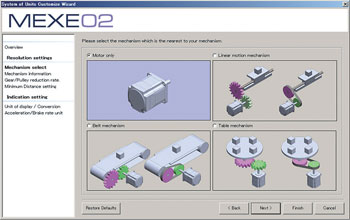Motor-Bee is designed to be simple to use, even for the complete beginner, with full instructions on how to connect to your external devices and create your control sequences.
Supplied with the Motor-Bee is Motor-Way control software. This allows full control over connected motors, servo and digital inputs and outputs. No computer programming knowledge is required. Motor-Way can be configured to match your connected devices up to the maximum of 4 DC motors and a servo. Once connected your motors can be controlled in both speed and direction, using the slider controls and the On/Off selectors. Please note that when a motor is connected for driving in both directions it uses two standard outputs . This means that MotorBee can drive two motors in full bi-directional mode or four Motors in uni-directional mode. It can also mix both modes and drive one motor bi-directional and two more uni-directional. When driving the motor in bi-directional mode you do, however, have separate speed control over both directions.
Servo Control. The servo, if connected, can be driven to both limits of travel (approx 180 degrees depending on servo type) using the slider control. This is graduated into 255 positions giving an approximate resolution of better than 1 degree !! (what is a servo ?)
Up to 24v Motors. Neither the Motors or the servo are limited to the standard 5v supply on the USB connector. The MotorBee has a separate connection point for external supplies. The Motor Driver IC used on the MotorBee can, in fact, handle up to 24v DC as the motor supply. Care should be taken, however, not to exceed the power handling capacities of the driver IC. Full details of this can be found in the manual (link below) and the data sheet for the device (L293D) which is provided on the installation CD.
Automatic Operation. Once you have your motors and/or servo attached to the MotorBee and operating in manual control, you can then consider developing your own control sequencer. This facility is provided within MotorWay. It allows a series of control 'steps' to be created (up to 10,000) in which each step has a duration and a set of configurations (eg speed direction etc.. ) for all attached devices. This sequence os steps can then be 'run' and you can sit back and watch your attached devices respond according to your specifications. Step sequences can be saved and restored to disk and edited using the facilities in MotorWay. This is a very easy (and fun) way to create some very interesting robotic and animation systems.
Digital I/O. The digital inputs and outputs available on the MotorBee offer the opportunity to enhance any control system by using sensors such as limit switches to influence the motor control. For example you may want to stop, slow or reverse a motor when a switch or photo sensor is triggered. Although the inputs are not directly used in this way on MotorWay they provide a very powerfull facility to more elaborate control systems under your own program control (see below).
A standard USB lead (not included) is needed to connect the Motor-Bee to your computer .
Writing Your Own Programs
If, however, you are already a competent programmer and wish to write your own programs for Motor-Bee then a DLL (dynamic link library) is provided on the installation disk which greatly simplifies this process. This DLL allows user programs written in a wide range of languages (eg C, C++ and Visual Basic), to have easy access to it's facilities. It provides standard functions which can be called from the library to initialise the Motor-Bee, set speeds, directions, positions, read inputs and send output bit patterns without having to get to know the details of USB operation or comms etc... For more detailed information on how to use this DLL and example source code for visual basic please follow this linkMotor-Bee Visual Basic
Information on programming in C++ is available within the manual, which may be downloaded below. For the Delphi programmers, there is an interesting article written by one of our customers at the following link. Writing Programs for MotorBee using Delphi
|
